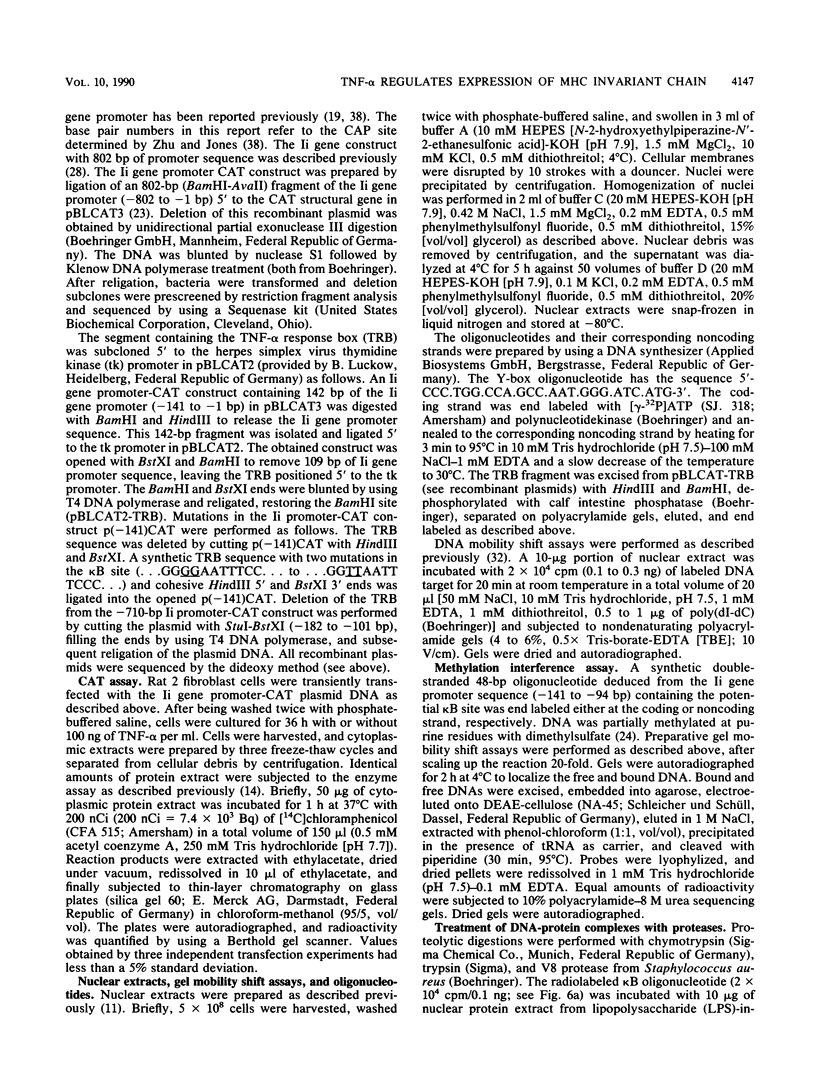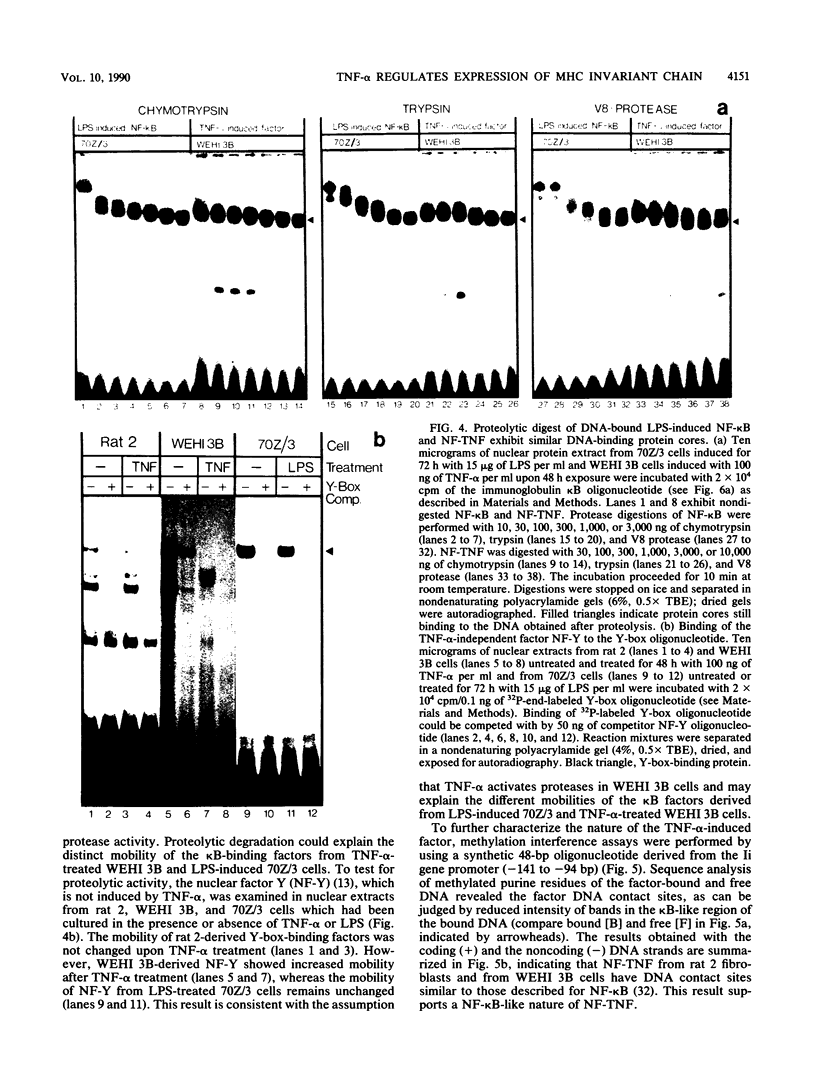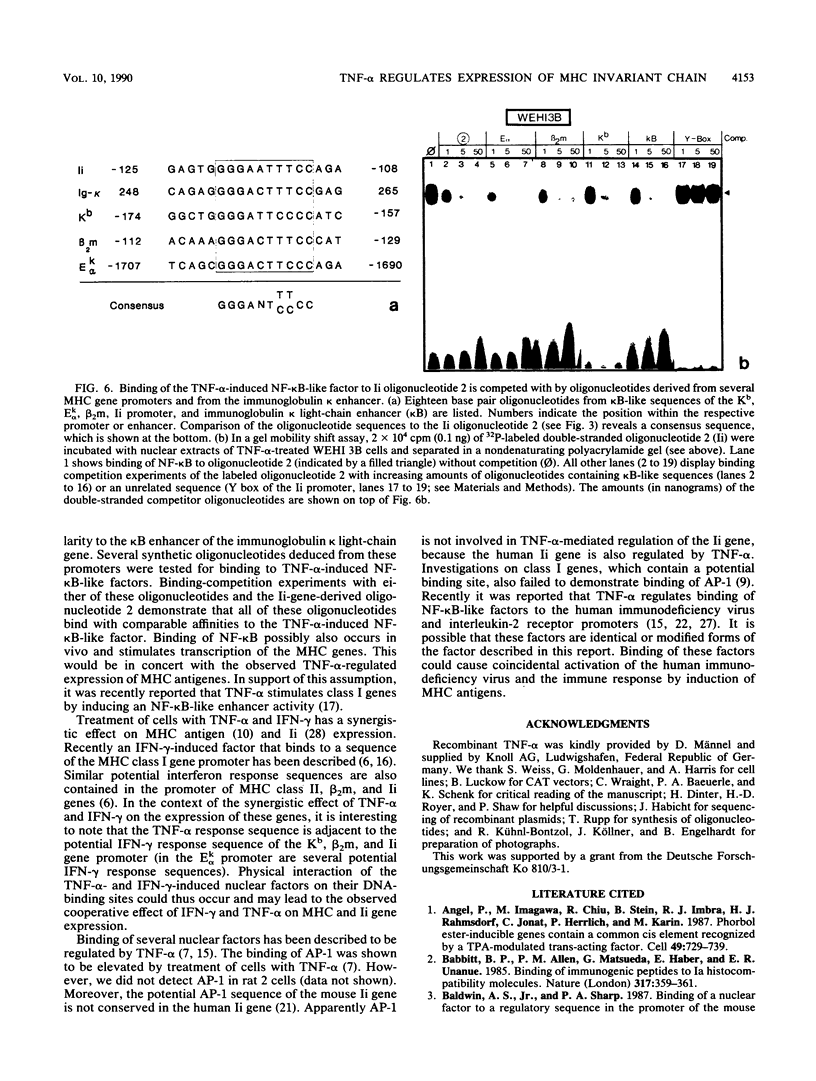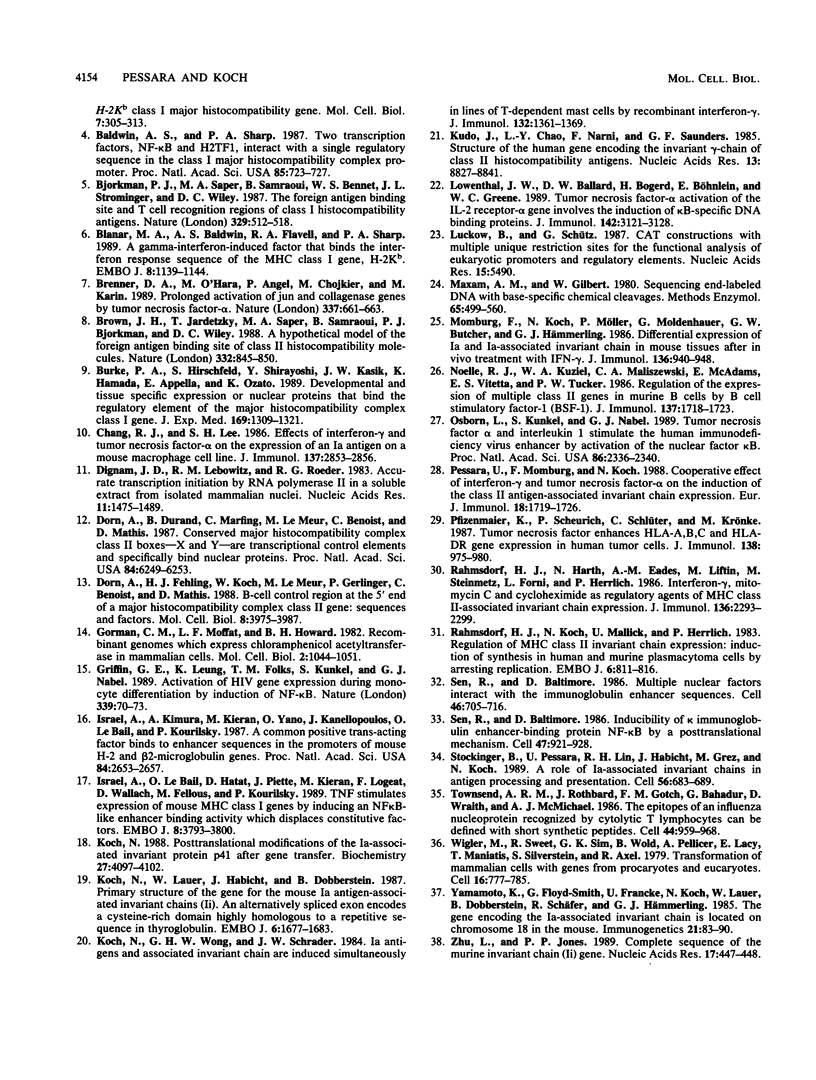Abstract
Expression of the major histocompatibility complex (MHC) class I and class II antigens and the class II-associated invariant chain (Ii) is strongly increased by treatment of cells with tumor necrosis factor alpha (TNF-alpha) and gamma interferon. We investigated elevation of expression of the invariant chain gene by TNF-alpha. Rat fibroblast cells transfected with the mouse Ii gene containing 802 base pairs of 5' sequences could be stimulated for Ii expression by treatment with TNF-alpha. Analysis of 5'-deleted Ii gene promoter-CAT constructs provided evidence for the presence of a TNF-alpha response box (TRB). Cloning of TRB in front of a non-TNF-alpha-responsive promoter could transfer the TNF-alpha stimulatory effect. We demonstrate binding of a TNF-alpha-induced factor to a kappa B-like motif within TRB. Mutations introduced into the kappa B element of the Ii promoter-CAT plasmid abolished the TNF-alpha-mediated stimulatory effect. Comparison of the TNF-alpha-induced factor and lipopolysaccharide-induced NF-kappa B in gel mobility shift assays upon partial protease digestion suggests similar DNA-binding protein cores. Further support for the NF-kappa B-like nature of the TNF-alpha-induced factor was obtained in methylation interference assays. The TNF-alpha-induced nuclear factor comprises DNA contact sites that are identical to those described for NF-kappa B. This TNF-alpha-induced factor also interacts with kappa B-like sequences of the MHC Kb, Ek alpha, and beta 2-microglobulin promoter, suggesting a common TNF-alpha-mediated regulatory signal for expression of MHC antigens and Ii.
Full text
PDF








Images in this article
Selected References
These references are in PubMed. This may not be the complete list of references from this article.
- Angel P., Imagawa M., Chiu R., Stein B., Imbra R. J., Rahmsdorf H. J., Jonat C., Herrlich P., Karin M. Phorbol ester-inducible genes contain a common cis element recognized by a TPA-modulated trans-acting factor. Cell. 1987 Jun 19;49(6):729–739. doi: 10.1016/0092-8674(87)90611-8. [DOI] [PubMed] [Google Scholar]
- Babbitt B. P., Allen P. M., Matsueda G., Haber E., Unanue E. R. Binding of immunogenic peptides to Ia histocompatibility molecules. 1985 Sep 26-Oct 2Nature. 317(6035):359–361. doi: 10.1038/317359a0. [DOI] [PubMed] [Google Scholar]
- Baldwin A. S., Jr, Sharp P. A. Two transcription factors, NF-kappa B and H2TF1, interact with a single regulatory sequence in the class I major histocompatibility complex promoter. Proc Natl Acad Sci U S A. 1988 Feb;85(3):723–727. doi: 10.1073/pnas.85.3.723. [DOI] [PMC free article] [PubMed] [Google Scholar]
- Bjorkman P. J., Saper M. A., Samraoui B., Bennett W. S., Strominger J. L., Wiley D. C. The foreign antigen binding site and T cell recognition regions of class I histocompatibility antigens. Nature. 1987 Oct 8;329(6139):512–518. doi: 10.1038/329512a0. [DOI] [PubMed] [Google Scholar]
- Blanar M. A., Baldwin A. S., Jr, Flavell R. A., Sharp P. A. A gamma-interferon-induced factor that binds the interferon response sequence of the MHC class I gene, H-2Kb. EMBO J. 1989 Apr;8(4):1139–1144. doi: 10.1002/j.1460-2075.1989.tb03484.x. [DOI] [PMC free article] [PubMed] [Google Scholar]
- Brenner D. A., O'Hara M., Angel P., Chojkier M., Karin M. Prolonged activation of jun and collagenase genes by tumour necrosis factor-alpha. Nature. 1989 Feb 16;337(6208):661–663. doi: 10.1038/337661a0. [DOI] [PubMed] [Google Scholar]
- Brown J. H., Jardetzky T., Saper M. A., Samraoui B., Bjorkman P. J., Wiley D. C. A hypothetical model of the foreign antigen binding site of class II histocompatibility molecules. Nature. 1988 Apr 28;332(6167):845–850. doi: 10.1038/332845a0. [DOI] [PubMed] [Google Scholar]
- Burke P. A., Hirschfeld S., Shirayoshi Y., Kasik J. W., Hamada K., Appella E., Ozato K. Developmental and tissue-specific expression of nuclear proteins that bind the regulatory element of the major histocompatibility complex class I gene. J Exp Med. 1989 Apr 1;169(4):1309–1321. doi: 10.1084/jem.169.4.1309. [DOI] [PMC free article] [PubMed] [Google Scholar]
- Chang R. J., Lee S. H. Effects of interferon-gamma and tumor necrosis factor-alpha on the expression of an Ia antigen on a murine macrophage cell line. J Immunol. 1986 Nov 1;137(9):2853–2856. [PubMed] [Google Scholar]
- Dignam J. D., Lebovitz R. M., Roeder R. G. Accurate transcription initiation by RNA polymerase II in a soluble extract from isolated mammalian nuclei. Nucleic Acids Res. 1983 Mar 11;11(5):1475–1489. doi: 10.1093/nar/11.5.1475. [DOI] [PMC free article] [PubMed] [Google Scholar]
- Dorn A., Durand B., Marfing C., Le Meur M., Benoist C., Mathis D. Conserved major histocompatibility complex class II boxes--X and Y--are transcriptional control elements and specifically bind nuclear proteins. Proc Natl Acad Sci U S A. 1987 Sep;84(17):6249–6253. doi: 10.1073/pnas.84.17.6249. [DOI] [PMC free article] [PubMed] [Google Scholar]
- Dorn A., Fehling H. J., Koch W., Le Meur M., Gerlinger P., Benoist C., Mathis D. B-cell control region at the 5' end of a major histocompatibility complex class II gene: sequences and factors. Mol Cell Biol. 1988 Oct;8(10):3975–3987. doi: 10.1128/mcb.8.10.3975. [DOI] [PMC free article] [PubMed] [Google Scholar]
- Gorman C. M., Moffat L. F., Howard B. H. Recombinant genomes which express chloramphenicol acetyltransferase in mammalian cells. Mol Cell Biol. 1982 Sep;2(9):1044–1051. doi: 10.1128/mcb.2.9.1044. [DOI] [PMC free article] [PubMed] [Google Scholar]
- Griffin G. E., Leung K., Folks T. M., Kunkel S., Nabel G. J. Activation of HIV gene expression during monocyte differentiation by induction of NF-kappa B. Nature. 1989 May 4;339(6219):70–73. doi: 10.1038/339070a0. [DOI] [PubMed] [Google Scholar]
- Israël A., Kimura A., Kieran M., Yano O., Kanellopoulos J., Le Bail O., Kourilsky P. A common positive trans-acting factor binds to enhancer sequences in the promoters of mouse H-2 and beta 2-microglobulin genes. Proc Natl Acad Sci U S A. 1987 May;84(9):2653–2657. doi: 10.1073/pnas.84.9.2653. [DOI] [PMC free article] [PubMed] [Google Scholar]
- Israël A., Le Bail O., Hatat D., Piette J., Kieran M., Logeat F., Wallach D., Fellous M., Kourilsky P. TNF stimulates expression of mouse MHC class I genes by inducing an NF kappa B-like enhancer binding activity which displaces constitutive factors. EMBO J. 1989 Dec 1;8(12):3793–3800. doi: 10.1002/j.1460-2075.1989.tb08556.x. [DOI] [PMC free article] [PubMed] [Google Scholar]
- Koch N., Lauer W., Habicht J., Dobberstein B. Primary structure of the gene for the murine Ia antigen-associated invariant chains (Ii). An alternatively spliced exon encodes a cysteine-rich domain highly homologous to a repetitive sequence of thyroglobulin. EMBO J. 1987 Jun;6(6):1677–1683. doi: 10.1002/j.1460-2075.1987.tb02417.x. [DOI] [PMC free article] [PubMed] [Google Scholar]
- Koch N. Posttranslational modifications of the Ia-associated invariant protein p41 after gene transfer. Biochemistry. 1988 May 31;27(11):4097–4102. doi: 10.1021/bi00411a028. [DOI] [PubMed] [Google Scholar]
- Koch N., Wong G. H., Schrader J. W. Ia antigens and associated invariant chain are induced simultaneously in lines of T-dependent mast cells by recombinant interferon-gamma. J Immunol. 1984 Mar;132(3):1361–1369. [PubMed] [Google Scholar]
- Kudo J., Chao L. Y., Narni F., Saunders G. F. Structure of the human gene encoding the invariant gamma-chain of class II histocompatibility antigens. Nucleic Acids Res. 1985 Dec 20;13(24):8827–8841. doi: 10.1093/nar/13.24.8827. [DOI] [PMC free article] [PubMed] [Google Scholar]
- Lowenthal J. W., Ballard D. W., Bogerd H., Böhnlein E., Greene W. C. Tumor necrosis factor-alpha activation of the IL-2 receptor-alpha gene involves the induction of kappa B-specific DNA binding proteins. J Immunol. 1989 May 1;142(9):3121–3128. [PubMed] [Google Scholar]
- Luckow B., Schütz G. CAT constructions with multiple unique restriction sites for the functional analysis of eukaryotic promoters and regulatory elements. Nucleic Acids Res. 1987 Jul 10;15(13):5490–5490. doi: 10.1093/nar/15.13.5490. [DOI] [PMC free article] [PubMed] [Google Scholar]
- Maxam A. M., Gilbert W. Sequencing end-labeled DNA with base-specific chemical cleavages. Methods Enzymol. 1980;65(1):499–560. doi: 10.1016/s0076-6879(80)65059-9. [DOI] [PubMed] [Google Scholar]
- Momburg F., Koch N., Möller P., Moldenhauer G., Butcher G. W., Hämmerling G. J. Differential expression of Ia and Ia-associated invariant chain in mouse tissues after in vivo treatment with IFN-gamma. J Immunol. 1986 Feb 1;136(3):940–948. [PubMed] [Google Scholar]
- Noelle R. J., Kuziel W. A., Maliszewski C. R., McAdams E., Vitetta E. S., Tucker P. W. Regulation of the expression of multiple class II genes in murine B cells by B cell stimulatory factor-1 (BSF-1). J Immunol. 1986 Sep 1;137(5):1718–1723. [PubMed] [Google Scholar]
- Osborn L., Kunkel S., Nabel G. J. Tumor necrosis factor alpha and interleukin 1 stimulate the human immunodeficiency virus enhancer by activation of the nuclear factor kappa B. Proc Natl Acad Sci U S A. 1989 Apr;86(7):2336–2340. doi: 10.1073/pnas.86.7.2336. [DOI] [PMC free article] [PubMed] [Google Scholar]
- Pessara U., Momburg F., Koch N. Cooperative effect of interferon-gamma and tumor necrosis factor-alpha on the induction of the class II antigen-associated invariant chain expression. Eur J Immunol. 1988 Nov;18(11):1719–1726. doi: 10.1002/eji.1830181110. [DOI] [PubMed] [Google Scholar]
- Pfizenmaier K., Scheurich P., Schlüter C., Krönke M. Tumor necrosis factor enhances HLA-A,B,C and HLA-DR gene expression in human tumor cells. J Immunol. 1987 Feb 1;138(3):975–980. [PubMed] [Google Scholar]
- Rahmsdorf H. J., Harth N., Eades A. M., Litfin M., Steinmetz M., Forni L., Herrlich P. Interferon-gamma, mitomycin C, and cycloheximide as regulatory agents of MHC class II-associated invariant chain expression. J Immunol. 1986 Mar 15;136(6):2293–2299. [PubMed] [Google Scholar]
- Rahmsdorf H. J., Koch N., Mallick U., Herrlich P. Regulation of MHC class II invariant chain expression: induction of synthesis in human and murine plasmocytoma cells by arresting replication. EMBO J. 1983;2(6):811–816. doi: 10.1002/j.1460-2075.1983.tb01507.x. [DOI] [PMC free article] [PubMed] [Google Scholar]
- Sen R., Baltimore D. Inducibility of kappa immunoglobulin enhancer-binding protein Nf-kappa B by a posttranslational mechanism. Cell. 1986 Dec 26;47(6):921–928. doi: 10.1016/0092-8674(86)90807-x. [DOI] [PubMed] [Google Scholar]
- Sen R., Baltimore D. Multiple nuclear factors interact with the immunoglobulin enhancer sequences. Cell. 1986 Aug 29;46(5):705–716. doi: 10.1016/0092-8674(86)90346-6. [DOI] [PubMed] [Google Scholar]
- Stockinger B., Pessara U., Lin R. H., Habicht J., Grez M., Koch N. A role of Ia-associated invariant chains in antigen processing and presentation. Cell. 1989 Feb 24;56(4):683–689. doi: 10.1016/0092-8674(89)90590-4. [DOI] [PubMed] [Google Scholar]
- Townsend A. R., Rothbard J., Gotch F. M., Bahadur G., Wraith D., McMichael A. J. The epitopes of influenza nucleoprotein recognized by cytotoxic T lymphocytes can be defined with short synthetic peptides. Cell. 1986 Mar 28;44(6):959–968. doi: 10.1016/0092-8674(86)90019-x. [DOI] [PubMed] [Google Scholar]
- Wigler M., Sweet R., Sim G. K., Wold B., Pellicer A., Lacy E., Maniatis T., Silverstein S., Axel R. Transformation of mammalian cells with genes from procaryotes and eucaryotes. Cell. 1979 Apr;16(4):777–785. doi: 10.1016/0092-8674(79)90093-x. [DOI] [PubMed] [Google Scholar]
- Yamamoto K., Floyd-Smith G., Francke U., Koch N., Lauer W., Dobberstein B., Schäfer R., Hämmerling G. J. The gene encoding the Ia-associated invariant chain is located on chromosome 18 in the mouse. Immunogenetics. 1985;21(1):83–90. doi: 10.1007/BF00372244. [DOI] [PubMed] [Google Scholar]
- Zhu L., Jones P. P. Complete sequence of the murine invariant chain (Ii) gene. Nucleic Acids Res. 1989 Jan 11;17(1):447–448. doi: 10.1093/nar/17.1.447. [DOI] [PMC free article] [PubMed] [Google Scholar]








